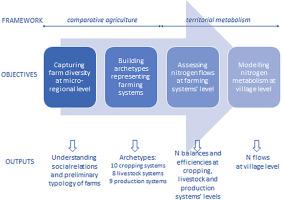Agricultural Systems ( IF 6.6 ) Pub Date : 2021-07-09 , DOI: 10.1016/j.agsy.2021.103218 Claire Aubron 1 , Mathieu Vigne 2 , Olivier Philippon 1 , Corentin Lucas 1 , Pierre Lesens 2 , Spencer Upton 1 , Paulo Salgado 2 , Laurent Ruiz 3, 4, 5

|
Context
Addressing the environmental impact of agriculture requires a comprehensive analysis of the system at stake, and accounting for the social diversity (i.e. social groups involved in farming and relationships between them) is particularly important for designing efficient policies aimed at mitigating these impacts. However, the integration of this diversity in environmental assessments remains challenging, partly due to the lack of frameworks for combining data and concepts belonging to bio-technical and social sciences.
Objective
In this study, we aimed at assessing how the combination of the conceptual frameworks of comparative agriculture and territorial metabolism helps to better understand the environmental impacts of agriculture. In particular, we look at the crop-livestock integration as a possible way to reduce nitrogen losses from agriculture, and study how social diversity shapes this integration.
Methods
Combining comparative agriculture and territorial metabolism frameworks, we carried out an intensive fieldwork in Petlad (Gujarat, India) organised in four steps so as to successively (i) capture farm diversity at the micro-regional level, (ii) build archetypes representing farming systems, (iii) assess nitrogen flows at farming systems' level and (iv) model nitrogen metabolism at village level.
Results and conclusions
We found that despite obvious potential, crop-livestock interactions were limited, accounting for minor nitrogen flows compared to the flow of inputs, mainly synthetic fertilisers and feed concentrates. The output flows, mainly tobacco, cereals and milk, were also low and most of the input nitrogen was lost to the environment (surplus of over 600 kg N/ha from the cropping system balance), contributing to pollution. While large subsidies for synthetic fertilisers had a role in the development of such huge surpluses, our study showed that this environmentally harmful situation was also influenced by the existing socio-economic conditions and social relations in Petlad. Most of the owners who had sufficient access to land (>1 ha) focused on the very profitable tobacco production and tended to abandon livestock, which they no longer needed either technically or economically. Conversely, households with low or no access to land were motivated to raise dairy animals, in order to supplement small incomes from crops, but faced difficulties in feeding them. We conclude that promoting crop-livestock integration as a potential lever to reduce nitrogen surplus would be unlikely to succeed in the presence of such a strong social lock-in.
Significance
Concurring with certain critiques of socio-ecological systems approaches, this result advocates for a better consideration of social diversity in the analysis of the environmental impacts of agriculture and in the design of interventions.
中文翻译:

基于比较农业方法的印度村庄的氮代谢:如何表征社会多样性对于理解作物 - 牲畜整合至关重要
语境
解决农业对环境的影响需要对所涉系统进行全面分析,考虑到社会多样性(即参与农业的社会群体及其之间的关系)对于设计旨在减轻这些影响的有效政策尤为重要。然而,在环境评估中整合这种多样性仍然具有挑战性,部分原因是缺乏将属于生物技术和社会科学的数据和概念相结合的框架。
客观的
在这项研究中,我们旨在评估比较农业和领土代谢的概念框架的结合如何有助于更好地了解农业的环境影响。特别是,我们将作物-牲畜整合视为减少农业氮损失的一种可能方式,并研究社会多样性如何塑造这种整合。
方法
结合比较农业和领土代谢框架,我们在 Petlad(印度古吉拉特邦)进行了密集的实地考察,分为四个步骤,依次(i)在微观区域层面捕捉农场多样性,(ii)建立代表农业系统的原型, (iii) 在农业系统层面评估氮流量和 (iv) 在村庄层面模拟氮代谢。
结果和结论
我们发现,尽管潜力明显,但作物与牲畜的相互作用有限,与投入物(主要是合成肥料和饲料浓缩物)的流量相比,氮流量较小。产出流量,主要是烟草、谷物和牛奶,也很低,大部分输入氮流失到环境中(种植系统平衡超过 600 公斤氮/公顷),造成污染。虽然对合成肥料的巨额补贴在产生如此巨大的盈余方面发挥了作用,但我们的研究表明,这种对环境有害的情况也受到佩特拉现有社会经济条件和社会关系的影响。大多数拥有足够土地(> 1 公顷)的所有者专注于非常有利可图的烟草生产,并倾向于放弃牲畜,他们在技术上或经济上不再需要。相反,没有土地或无法获得土地的家庭有动力饲养奶牛,以补充农作物的微薄收入,但在喂养它们方面面临困难。我们得出的结论是,在存在如此强烈的社会锁定的情况下,促进作物-畜牧一体化作为减少氮过剩的潜在杠杆不太可能成功。
意义
与对社会生态系统方法的某些批评一致,该结果主张在分析农业的环境影响和设计干预措施时更好地考虑社会多样性。



























 京公网安备 11010802027423号
京公网安备 11010802027423号